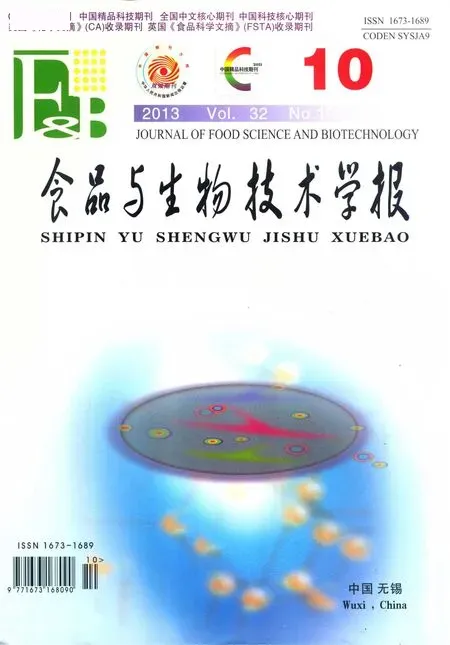细菌内毒素的生物合成途径及分子结构多样性
王小元 , 宋鸿军
(1.食品科学与技术国家重点实验室 江南大学,江苏 无锡 214122;2.食品安全与营养协同创新中心 江南大学,江苏 无锡214122;3.廊坊卫生职业学院,河北 廊坊 065001)
细菌内毒素是革兰氏阴性细菌细胞外膜的主要组分,又名脂多糖 (LPS),主要由Kdo2-类脂A(Kdo2-lipid A)、 核心糖 (Core)和 O-抗原 (O-antigen)重复单元3部分组成,其中Kdo2-lipid A基团是内毒素的主要活性成分[1]。革兰氏阴性菌侵入宿主后会释放其表层的内毒素[2]。这些内毒素可被免疫细胞表面的TLR4/MD2受体识别,在细胞内引发一系列生化反应,产生多种细胞因子[3]。这些细胞因子的种类和数量取决于内毒素分子的精细结构。有些细胞因子的过量积累能够引起严重的内毒素休克;而有些细胞因子的适量产生可以加强宿主的先天性免疫能力。所以,研究内毒素的生物合成途径及其结构多样性有助于开发新型的细菌疫苗和疫苗佐剂。
1 内毒素分子最保守基团Kdo2-lipid A的合成
内毒素的主要活性成分Kdo2-lipid A基团也是LPS分子的最保守部分。在革兰氏阴性细菌的模式菌株大肠杆菌中,Kdo2-lipid A含有2个Kdo、2个氨基葡萄糖、2个磷酸基团和6条脂肪酸链(图1)。大肠杆菌Kdo2-lipid A的合成主要发生在细胞质和内膜内层,先后涉及9个酶催化的9步反应(图1)。这9个酶存在于大多数变形杆菌中,具有较高的保守性[4]。Kdo2-lipid A的合成是从小分子UDP-氨基葡萄糖乙酸酐(UDP-GlcAc)开始的。前3步反应分别由可溶性蛋白酶LpxA、LpxC和LpxD催化,在UDP-GlcAc分子上加了2条脂肪酸链。LpxA和LpxD存在45%的序列相似性,有类似的三聚体结构,但存在不同的四级结构和活性位点[5-6]。因为LpxA催化的第1步反应是可逆反应,所以LpxC催化的第2步反应成为Kdo2-lipid A合成的第一个关键步骤,决定着内毒素分子的合成效率。第4步反应由膜外周蛋白酶LpxH将UDP-GlcAc的UDP分解,形成Lipid X分子。第5步反应由膜外周蛋白酶LpxB将Lipid X及其前体分子聚合;接着磷酸激酶LpxK在4′位上添加1个磷酸基团,形成Lipid IVA分子。第7步反应由膜蛋白KdtA在Lipid IVA分子的6′位上连续加2个Kdo基团;最后膜蛋白LpxL和LpxM先后在2′和3′位上分别加上1个二级脂肪酸链,形成Kdo2-lipid A分子(图1)。
在Kdo2-lipid A的合成过程中,各种酶的疏水性与其所催化反应的底物分子结构相吻合。最初反应底物是水溶性的UDP-GlcNAc,所以用到的酶LpxA、LpxC和LpxD均为水溶性蛋白。随着反应的进行,底物分子中的脂肪酸链越来越多,逐渐变成兼性分子,所以反应也转移到膜上进行,催化这些反应的酶LpxK、KdtA、LpxL和LpxM等也均为膜蛋白。参与Kdo2-lipid A合成的酶专一性都很强,参加反应顺序也很严格。比如,LpxA和LpxD虽然都能催化酰基化反应,却不能互换使用;酰基化酶LpxL和LpxM必须等KdtA加完两个Kdo之后,才能分别将第5和第6个脂肪酸链添加上去。Kdo2-lipid A的合成效率受到膜蛋白降解酶FtsH的调控[7]。当细胞内Kdo2-lipid A过量时,FtsH通过降解关键酶LpxC和KdtA来降低其合成速度[8]。
2 内毒素分子跨越细胞的内膜和外膜
当Kdo2-lipid A的合成在内膜内层完成后,约10个左右的酶依次将一些单糖基团连接上去,形成Core-lipid A(图2)。接着,转运蛋白MsbA将Corelipid A从内膜的内侧转运到内膜的外侧[9]。O-antigen也是在内膜的内侧合成、被连接到细菌萜醇上,并通过转运蛋白Wzx翻转到内膜的外侧[10]。
在周质空间中,聚合酶Wzy和Wzz首先将O-antigen聚合,然后连接酶WaaL将O-antigen重复单元连接到Core-lipid A上,组装成完整的LPS[15]。接下来,LPS运输系统(Lpt)负责将LPS从内膜外层转运到外膜外层[11]。Lpt系统由7个蛋白质(LptA、LptB、LptC、LptD、LptE、LptF 和 LptG)组成,有的分布在内膜,有的分布在周质空间,有的分布在外膜。LptB、LptC、LptF和LptG以复合体LptBCFG的形式存在,其中LptC的作用就像是周质蛋白LptA的锚。LptA可以结合LPS,并将其从内膜外层转运给位于外膜内层的膜蛋白LptD。LptD与脂蛋白LptE一起将LPS从外膜内层转运到外膜外层。Lpt系统中的7个蛋白质可能以一个从内膜到外膜横跨周质空间的复合体存在,协调一致地转运LPS[12]。
3 内毒素分子结构多样性
为适应不断变化的外界环境,一些革兰氏阴性细菌进化出改变内毒素分子结构的机制。由于内毒素的主要活性成分是Kdo2-lipid A基团,所以有关Kdo2-lipid A分子结构多样性的研究比较集中。许多革兰氏阴性菌的基因组中都存在像大肠杆菌一样编码合成Kdo2-lipid A的9个酶的基因,所以内毒素分子结构的改变主要由其它基因编码的酶引起。这些能改变内毒素分子结构的酶多数位于内膜,但也有位于外膜的。
不同细菌内毒素分子脂肪酸链的数目和长度会有差异。固氮菌内毒素分子的2′位上有1条含有32个碳的超长次级脂肪酸,有利于其生存在豆科植物根部[13]。低温条件下,大肠杆菌中的LpxP[14]取代LpxL在 Kdo2-lipid A的 2′位上加了 1条不饱和C16次级脂肪酸,而弗朗西斯菌中的LpxD2[15]取代LpxD1在内毒素分子的2和2′位上加了1条较短的3-OH脂肪酸。有氧条件下,沙门氏菌细胞内膜上的酶LpxO以Fe2+和α-酮戊二酸为辅助因子在3?位的次级脂肪酸链上引入1个羟基[16]。存在高浓度Ca2+的情况下,沙门氏菌和幽门螺旋杆菌中存在LpxR可以去除内毒素分子 3′位上的脂肪酸链[17]。

图2 大肠杆菌内毒素分子的合成及跨膜转运示意图Fig.2 Biosynthesis and transport of endotoxin molecules in E.coli.
不同细菌内毒素分子上的磷酸基团会被修饰。弗朗西斯菌、根瘤菌和幽门螺旋杆菌的LpxE能特异性地去除内毒素分子1位上的磷酸基团[18]。有氧条件下,根瘤菌外膜蛋白LpxQ可以在LpxE脱1位磷酸的基础上将氨基葡萄糖转变为2-氨基葡萄糖酸[19]。Kdo2-lipid A分子4′位的磷酸基团可以被在弗朗西斯菌发现的磷酸酶LpxF特异性地去除[20]。LpxF缺失突变的弗朗西斯菌不再具有侵染小鼠的能力,说明内毒素分子结构的修饰与细菌的致病能力密切相关[21]。LpxT利用十一异戊烯醇焦磷酸为供体在Kdo2-lipid A基团 1位磷酸基团上添加第二个磷酸基团形成焦磷酸结构[22]。钩端螺旋体中LmtA可以将S-腺苷甲硫氨酸的甲基转移至Kdo2-lipid A的1位磷酸基团上[23]。沙门氏菌EptA在Kdo2-lipid A基团的1位磷酸基团上添加磷酸乙醇胺[24],其表达受PmrA-PmrB二元系统调控[25]。PmrB是位于细胞膜上的感受蛋白,而PmrA是位于细胞质内的响应蛋白。PmrB可以感受环境中高浓度的Fe3+和低pH,并通过PmrA激活特定基因的转录。幽门螺旋杆菌EptA在Kdo2-lipid A分子的1位上用磷酸乙醇胺取代了原来的磷酸基团[26]。幽门螺旋杆菌中还存在一个具有双重功能的EptC,它不仅在Kdo2-lipid A分子的1位或4′上加磷酸乙醇胺,而且在鞭毛蛋白FlgG也能添加磷酸乙醇胺[27]。ArnT将L-Ara4N从特定供体转移至内毒素分子1位或4′位的磷酸基团上[28]。弗朗西斯菌的1位磷酸基团被半乳糖胺基团用同样的机制所修饰,ArnT的同源蛋白FlmK催化完成半乳糖胺基团的转移[29]。
内毒素分子的Kdo基团也可以被修饰。固氮菌中RgtA和RgtB可以分别在Kdo2-lipid A分子上的外Kdo基团上加上一个半乳糖醛酸(GalA)[30];大肠杆菌中EptB也可以在Kdo′-lipid A分子上的外Kdo基团上加上一个磷酸乙醇胺[31]。
位于细胞外膜可以改变内毒素分子结构的酶主要有PagP和PagL。沙门氏菌中位于细胞外膜的酰基转移酶PagP可以将磷脂的C16碳脂肪酸链转移到内毒素分子的2位脂肪酸链上,形成1条次级脂肪酸链。PagP产生的含有7条脂肪酸链的内毒素可以干扰TLR4的识别,使细菌对阳离子抗菌肽产生抗性[32]。PagP的活性位点朝向细胞外膜外侧[33],通常情况下PagP在细胞膜中表达水平低且没有活性。当外膜外层结构遭到破坏而外膜渗透性增加时,外膜内层的磷脂会向外膜外侧转运,为PagP提供脂肪酸供体,同时PagP被迅速激活,修饰内毒素分子的结构来快速修复外膜渗透性。PagP的转录水平受PhoP-PhoQ调控[34]。PhoQ是位于细胞膜上的感受蛋白,而PhoP是位于细胞质内的响应蛋白。PhoQ可以感受环境中阳离子抗菌肽、低pH和低浓度的二价阳离子等。PagL是细胞外膜上的一种脱酰基酶,能特异性地水解去除内毒素分子3位上的脂肪酸链,使其不被TLR4识别,有利于细菌躲避宿主免疫系统的攻击[35]。PagL的蛋白结构与PagP类似,也受PhoP-PhoQ二元系统和细菌外膜渗透性的调控。沙门氏菌Kdo2-lipid A分子上L-Ara4N的存在可以抑制PagL的活性[36]。PagL细胞外侧一些特定的氨基酸序列可以识别L-Ara4N修饰的Kdo2-lipid A,而活性位点之间相互结合形成二聚体可能是PagL失活的原因[37]。
4 内毒素研究的应用前景
内毒素分子能够通过TLR4/MD2刺激宿主先天性免疫系统,因此内毒素结构修饰的研究可为细菌疫苗和疫苗佐剂的开发奠定基础。一方面可以通过优化其结构开发疫苗佐剂[38],另一方面可以将一些革兰氏阴性病原菌的内毒素分子结构优化来开发减毒疫苗[39]。由于内毒素分子位于细胞表层,它在维持革兰氏阴性细菌细胞外膜渗透性和完整性中起主要作用。所以,通过定向改造内毒素分子结构,可以改善革兰氏阴性工业生产菌的细胞膜通透性,提高其生产效率。由于内毒素分子通过影响细菌细胞外膜的完整性来决定细菌的存亡,其合成和转运过程中所涉及到的各种关键蛋白可以被作为靶点来开发新型抗菌素[40]。
[1]WANG X,Quinn P J.Lipopolysaccharide:Biosynthetic pathway and structure modification[J].Progress in Lipid Research,2010,49:97-107.
[2]Ellis T N,Kuehn M J.Virulence and immunomodulatory roles of bacterial outer membrane vesicles[J].Microbiology Molecular Biology Review,2010,74:81-94.
[3]Maeshima N,Fernandez R C.Recognition of lipid A variants by the TLR4-MD-2 receptor complex[J].Frontiers in Cellular and Infection Microbiology,2013;3:3.
[4]Opiyo S O,Pardy R L,Moriyama H.Evolution of the Kdo2-lipid A biosynthesis in bacteria[J].BMC Evolution Biology,2010,10:362-375.
[5]Williams A H,Raetz C R.Structural basis for the acyl chain selectivity and mechanism of UDP-N-acetylglucosamine acyltransferase[J].Proceedings of the National Academy of Sciences of USA,2007,104:13543-13550.
[6]Bartling C M,Raetz C R.Crystal structure and acyl chain selectivity of Escherichia coli LpxD,the N-acyltransferase of lipid A biosynthesis[J].Biochemistry,2009,48:8672-8683.
[7]Langklotz S,Baumann U,Narberhaus F.Structure and function of the bacterial AAA protease FtsH[J].Biochimica et Biophysica Acta,2012,1823:40-48.
[8]Langklotz S,Schakermann M,Narberhaus F.Control of lipopolysaccharide biosynthesis by FtsH-mediated proteolysis of LpxC is conserved in enterobacteria but not in all gram-negative bacteria[J].Journal of Bacteriology,2011,193:1090-1097.
[9]Doshi R,Ali A,Shi W,et al.Molecular disruption of the power stroke in the ATP-binding cassette transport protein MsbA[J].The Journal of Biological Chemistry,2013,288:6801-6813.
[10]Islam S T,Eckford P D,Jones M L,et al.Proton-dependent gating and proton uptake by wzx support o-antigen-subunit antiport across the bacterial inner membrane[J].MBio,2013,4(5).doi:pii:e00678-13.10.1128/mBio.00678-13.
[11]Villa R,Martorana AM,Okuda S,et al.The Escherichia coli Lpt transenvelope protein complex for lipopolysaccharide export is assembled via conserved structurally homologous domains[J].Journal of Bacteriology,2013,195:1100-1108.
[12]Okuda S,Freinkman E,Kahne D.Cytoplasmic ATP hydrolysis powers transport of lipopolysaccharide across the periplasm in E.coli[J].Science,2012,338:1214-1217.
[13]Haag A F,Wehmeier S,Muszyński A,et al.Biochemical characterization of Sinorhizobium meliloti mutants reveals gene products involved in the biosynthesis of the unusual lipid A very long-chain fatty acid[J].Journal of Biological Chemistry,2011,286:17455-17466.
[14]Vorachek-Warren M K,CartyS M,Lin S,etal.An Escherichiacolimutantlackingthecold shock-induced palmitoleoyltransferase of lipid A biosynthesis:absence of unsaturated acyl chains and antibiotic hypersensitivity at 12 degrees C[J].Journal of Biological Chemistry,2002,277:14186-14193.
[15]Li Y,Powell D A,Shaffer S A,et al.LPS remodeling is an evolved survival strategy for bacteria[J].Proceedings of the National Academy of Sciences of USA,2012,109:8716-8721.
[16]Gibbons H S,Reynolds C M,Guan Z,et al.An inner membrane dioxygenase that generates the 2-hydroxymyristate moiety of Salmonella lipid A[J].Biochemistry,2008,47:2814-2825.
[17]Rutten L,Mannie J P,Stead C M,et al.Active-site architecture and catalytic mechanism of the lipid A deacylase LpxR of Salmonella typhimurium[J].Proceedings of the National Academy of Sciences of USA,2009,106:1960-1964.
[18]Wang X,Karbarz M J,McGrath S C,et al.MsbA transporter-dependent lipid A 1-dephosphorylation on the periplasmic surface of the inner membrane:topography of Francisella novicida LpxE expressed in Escherichia coli[J].Journal of Biological Chemistry,2004,279:49470-49478.
[19]Que-Gewirth N L S,Karbarz M J,Kalb S R,et al.Origin of the 2-amino-2-deoxy-gluconate unit in Rhizobium leguminosarum lipid A.Expression cloning of the outer membrane oxidase LpxQ[J].Journal of Biological Chemistry,2003,278:12120-12129.
[20]Wang X,McGrath S C,Cotter R J,et al.Expression cloning and periplasmic orientation of the Francisella novicida lipid A 4'-phosphatase LpxF[J].Journal of Biological Chemistry,2006,281:9321-9330.
[21]Wang X,Ribeiro A A,Guan Z,et al.Attenuated virulence of a Francisella mutant lacking the lipid A 4'-phosphatase[J].Proceedings of the National Academy of Sciences of USA,2007,104:4136-4141.
[22]Herrera C M,Hankins J V,Trent M S.Activation of PmrA inhibits LpxT-dependent phosphorylation of lipid A promoting resistance to antimicrobial peptides[J].Molecular Microbiology,2010,76:1444-1460.
[23]Boon Hinckley M,Reynolds C M,Ribeiro A A,et al.A Leptospira interrogans enzyme with similarity to yeast Ste14p that methylates the 1-phosphate group of lipid A[J].Journal of Biological Chemistry,2005,280:30214-30224.
[24]Lee H,Hsu FF,Turk J.The PmrA-regulated pmrC gene mediates phosphoethanolamine modification of lipid A and polymyxin resistance in Salmonella enterica[J].Journal of Bacteriology,2004,186:4124-4133.
[25]Winfield M D,Groisman E A.Phenotypic differences between Salmonella and Escherichia coli resulting from the disparate regulation of homologous genes[J].Proceedings of the National Academy of Sciences of USA,2004,101:17162-17167.
[26]Tran A X,Whittimore J D,Wyrick P B,et al.The lipid A 1-phosphatase of Helicobacter pylori is required for resistance to the antimicrobial peptide polymyxin[J].Journal of Bacteriology,2006,188:4531-4541.
[27]Cullen T W,Trent M S.A link between the assembly of flagella and lipooligosaccharide of the Gram-negative bacterium Campylobacter jejuni[J].Proceedings of the National Academy of Sciences of USA,2010,107:5160-5165.
[28]Yan A,Guan Z,Raetz C R.An undecaprenyl phosphate-aminoarabinose flippase required for polymyxin resistance in Escherichia coli[J].Journal of Biological Chemistry,2007,282:36077-36089.
[29]Wang X,Ribeiro A A,Guan Z,et al.Identification of undecaprenyl phosphate-beta-D-galactosamine in Francisella novicida and its function in lipid A modification[J].Biochemistry,2009,48:1162-1172.
[30]Kanjilal-Kolar S,Basu S S,Kanipes M I,et al.Expression cloning of three Rhizobium leguminosarum lipopolysaccharide core galacturonosyltransferases[J].Journal of Biological Chemistry,2006,281:12865-12878.
[31]Reynolds C M,Kalb S R,Cotter R J,et al.A phosphoethanolamine transferase specific for the outer 3-deoxy-D-mannooctulosonic acid residue of Escherichia coli lipopolysaccharide.Identification of the eptB gene and Ca2+hypersensitivity of an eptB deletion mutant[J].Journal of Biological Chemistry,2005,280:21202-21211.
[32]Bishop R E,Gibbons H S,Guina T,et al.Transfer of palmitate from phospholipids to lipid A in outer membranes of gramnegative bacteria[J].EMBO Journal,2000,19:5071-5080.
[33]Hwang P M,Choy W Y,Lo E I,et al.Solution structure and dynamics of the outer membrane enzyme PagP by NMR[J].Proceedings of the National Academy of Sciences of USA,2002,99:13560-13565.
[34]Guo L,Lim K B,Gunn J S,et al.Regulation of lipid A modifications by Salmonella typhimurium virulence genes phoP-phoQ[J].Science,1997,276:250-253.
[35]Kawasaki K,Ernst R K,Miller S I.3-O-deacylation of lipid A by PagL,a PhoP/PhoQ-regulated deacylase of Salmonella typhimurium,modulates signaling through Toll-like receptor 4[J].Journal of Biological Chemistry,2004,279:20044-20048.
[36]Kawasaki K,China K,Nishijima M.Release of the lipopolysaccharide deacylase PagL from latency compensates for a lack of lipopolysaccharide aminoarabinose modification-dependent resistance to the antimicrobial peptide polymyxin B in Salmonella enterica[J].Journal of Bacteriology,2007,189:4911-4919.
[37]Rutten L,Geurtsen J,Lambert W,et al.Crystal structure and catalytic mechanism of the LPS 3-O-deacylase PagL from Pseudomonas aeruginosa[J].Proceedings of the National Academy of Sciences of USA,2006,103:7071-7076.
[38]Han Y,Li Y,Chen J,et al.Construction of monophosphoryl lipid A producing Escherichia coli mutants and comparison of immuno-stimulatory activities of their lipopolysaccharides[J].Marine Drugs,2013,11:363-376.
[39]Kong Q,Six D A,Roland K L,et al.Salmonella synthesizing 1-monophosphorylated lipopolysaccharide exhibits low endotoxic activity while retaining its immunogenicity[J].Journal of Immunology,2011,187:412-423.
[40]Zhang J,Zhang L,Li X,et al.UDP-3-O-(R-3-hydroxymyristoyl)-N-acetylglucosamine deacetylase (LpxC)inhibitors:a new class of antibacterial agents[J].Current Medicinal Chemistry,2012;19(13):2038-50.

